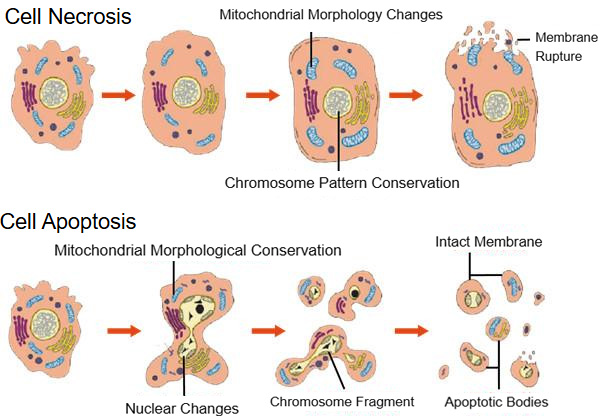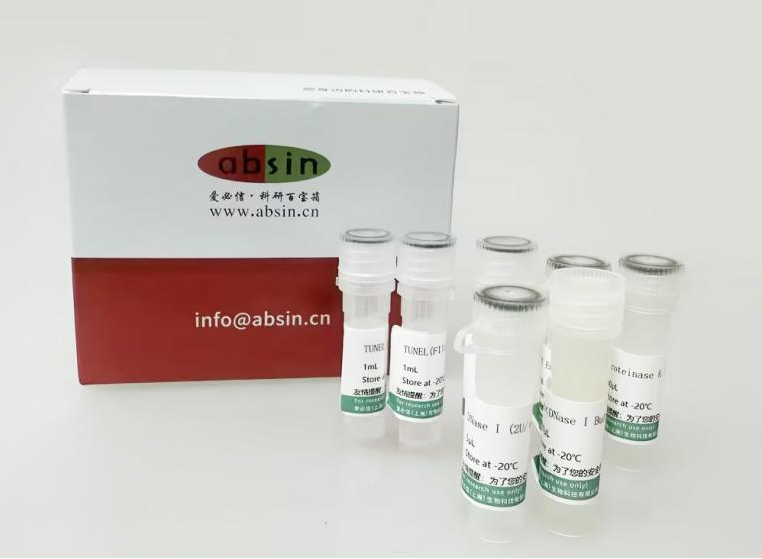- Cart 0
- English
Selection Guide for Apoptosis Detection Kits
February 10, 2025
Clicks:754
Concept:
Apoptosis: A genetically controlled, autonomous, and orderly cell death process that is highly regulated and thus also known as programmed cell death.
Characteristics:
Necrosis is an autolytic phenomenon induced by injury factors under pathological conditions, while apoptosis is akin to cell suicide, characterized by: cell shrinkage, plasma membrane blebbing, chromatin condensation, nuclear fragmentation, DNA fragmentation, and eventual phagocytosis of the cell by phagosomes.

Figure 1: Process of Apoptosis and Necrosis
Detection Kits:
1. Annexin V/PI Detection Kit
Based on the changes during apoptosis, cell apoptosis can be detected through various methods. The commonly used kits available on the market include the following:

Annexin V-FITC/PI Apoptosis Detection Kit (abs50001)
In normal cells, phosphatidylserine (PS) is only distributed on the inner side of the plasma membrane lipid bilayer. During the earliest stages of apoptosis, PS is translocated to the outer side of the membrane, which occurs before cell shrinkage, chromatin condensation, DNA fragmentation, and increased membrane permeability. Annexin V has a high affinity for PS and is thus used as one of the sensitive indicators for early apoptosis detection. Propidium iodide (PI) is a nucleic acid dye that cannot penetrate intact cell membranes. However, during late apoptosis and in dead cells, due to increased membrane permeability, PI can enter the cell and stain the nucleus red. Therefore, by combining Annexin V with PI, cells at different stages of apoptosis can be distinguished. Since Annexin V itself does not have fluorescence, it needs to be conjugated with a fluorescent group to be detected by flow cytometry, typically with FITC, eGFP, AF488, APC, etc.
Selection principle: If cells do not have spontaneous fluorescence, Annexin V-FITC/PI or Annexin V-eGFP/PI can be chosen. These kits have minimal fluorescence spectrum overlap and relatively lower technical requirements for the experimenter.
If the cells themselves need to be detected for green fluorescence, Annexin V-APC/PI or the combination of Annexin V-APC/7-AAD kits can be selected. However, APC and PI have significant fluorescence spectrum overlap, which requires higher demands on the detection instrument and technicians. If the cells themselves need to be detected for red fluorescence, the excitation and emission wavelengths of the red fluorescence should be confirmed. If they are similar to those of PI/7-AAD, these kits should not be used to detect apoptosis in such cells.
2. TUNEL Apoptosis Detection Kit

TUNEL Apoptosis Detection Kit (Green Fluorescence) abs50047

TUNEL Staining Fluorescence Image (Green)
During apoptosis, certain DNA endonucleases are activated, which cleave genomic DNA between nucleosomes. When genomic DNA double-strands or single-strands are cleaved, a large number of sticky 3'-OH ends are produced. Normal or proliferating cells have almost no DNA breaks and thus no 3'-OH formation. The 3'-OH can be labeled with 488/Cy-dUTP under the catalysis of terminal deoxynucleotidyl transferase (TdT), allowing direct detection of apoptotic cells via fluorescence microscopy or flow cytometry. This method is known as Terminal -deoxynucleotidyl transferase mediated nick end labeling (TUNEL).
Selection guide: The TUNEL method can perform in situ staining of individual apoptotic cell nuclei or apoptotic bodies and can detect a very small number of apoptotic cells. It can be used to detect apoptosis in frozen or paraffin sections and in adherent or suspended cultured cells. It selectively detects apoptotic cells rather than necrotic cells or cells with DNA strand breaks caused by irradiation and drug treatment. It can be detected by flow cytometry or observed under a fluorescence microscope after smearing.
3. Caspase 3/7 Activity Detection Kit
The Caspase 3/7 Activity Detection Kit is a kit that uses spectrophotometry to detect the activity of caspase 3/7 enzymes in cell or tissue lysates or purified caspase 3/7 enzymes. Caspase (Cysteine-requiring Aspartate Protease) is a family of proteases that play an important role in apoptosis. Caspase 3 is the most extensively studied caspase in mammalian cells. The principle of this kit is based on the fact that both Caspase 3/7 can catalyze the substrate Ac-DEVD-pNA to produce yellow pNA (p-nitroaniline), and the absorbance of pNA at around 405 nm is measured.
4. Mitochondrial Membrane Potential Detection Kit
JC-1 is an ideal fluorescent probe widely used for detecting mitochondrial membrane potential ΔΨm and can be used to detect the membrane potential of mitochondria in cells, tissues, or purified mitochondria. When the mitochondrial membrane potential is high, JC-1 aggregates in the mitochondrial matrix, forming polymers that produce red fluorescence; when the mitochondrial membrane potential is low, JC-1 cannot aggregate in the mitochondrial matrix, and JC-1 is in a monomeric state, producing green fluorescence. Thus, it is very convenient to detect changes in mitochondrial membrane potential by the shift in fluorescence color. The relative ratio of red to green fluorescence is commonly used to measure the degree of mitochondrial depolarization. The decrease in mitochondrial membrane potential is a hallmark event in early apoptosis. Therefore, this kit can be used for early apoptosis detection.
*Note: Images in the text are sourced from the internet or references for educational purposes only.
|
Catalog No. |
Product Name |
Specification |
|
Annexin V-FITC/PI Apoptosis Detection Kit |
100T |
|
|
Annexin V-APC/7-AAD Apoptosis Detection Kit |
100T |
|
|
Annexin V-APC/PI Apoptosis Detection Kit |
100T |
|
|
Annexin V-EGFP/PI Apoptosis Detection Kit |
50T |
|
|
TUNEL Apoptosis Detection Kit (Green Fluorescence) |
50T |
|
|
Caspase 3/7 Activity Detection Kit |
20T/100T |
|
|
Mitochondrial Membrane Potential Detection Kit (JC-1) |
100T |
|
|
Mitochondrial Membrane Potential Detection Kit (JC-10) |
100T |
Absin provides antibodies, proteins, ELISA kits, cell culture, detection kits, and other research reagents. If you have any product needs, please contact us
|
Absin Bioscience Inc. |
 Follow us on Facebook: Absin Bio Follow us on Facebook: Absin Bio |
